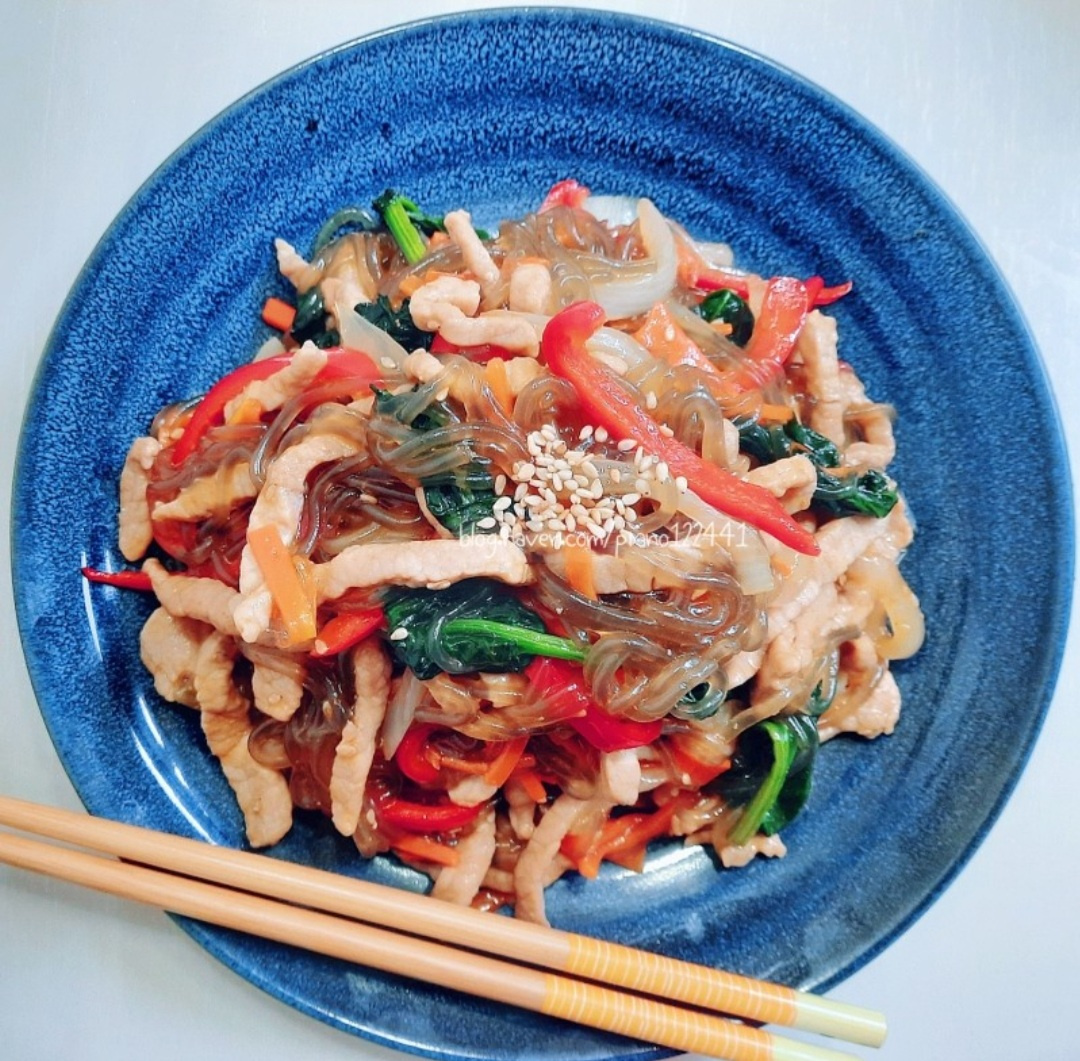Super Simple One-Pan Japchae
Say Goodbye to Hassle! Delicious One-Pan Japchae Made Easy!

Japchae, often considered a dish for special occasions due to its intricate preparation, is now simplified into a delightful one-pan wonder! We’ve stripped away the complexity, leaving you with an incredibly easy yet flavorful recipe. This one-pan method is not only convenient but also delivers the authentic, delicious taste you love. Get ready to enjoy Japchae more often!
Main Ingredients- 300g Beef for Japchae (thinly sliced)
- 1/2 Onion
- 1/2 Carrot
- 1/2 Red Bell Pepper
- 1 cup Spinach
- 2 servings Dried Glass Noodles
- 2 cups Water (for soaking noodles)
Japchae Seasoning- 5 Tbsp Soy Sauce
- 5 Tbsp Mirin (or Cooking Wine)
- 2 Tbsp Sugar
- 1 Tbsp Sesame Oil
- 1 Tbsp Toasted Sesame Seeds
- 5 Tbsp Soy Sauce
- 5 Tbsp Mirin (or Cooking Wine)
- 2 Tbsp Sugar
- 1 Tbsp Sesame Oil
- 1 Tbsp Toasted Sesame Seeds
Cooking Instructions
Step 1
First, prepare the glass noodles. If you find long noodles cumbersome, feel free to cut them in half to your desired length before soaking. Soak the dried glass noodles in cold water for about 1 hour until they become pliable and soft. This soaking process ensures the noodles absorb the flavors beautifully.

Step 2
Next, prepare the colorful vegetables. Wash the onion, carrot, and red bell pepper. Thinly slice them into julienne strips. The carrots will add sweetness and color, while the bell pepper will provide a crisp texture and vibrant hue.

Step 3
Let’s make the essential seasoning sauce for your delicious Japchae. In a bowl, combine 5 tablespoons of soy sauce, 5 tablespoons of mirin (or cooking wine), and 2 tablespoons of sugar. Stir well until the sugar is completely dissolved. This perfectly balanced sauce is key to the rich flavor of the Japchae.

Step 4
Now, get your frying pan ready for the one-pan Japchae! We’ll start by stir-frying the beef. Place the thinly sliced beef in the pan. Season it with a pinch of black pepper, a pinch of salt, and 1 tablespoon of mirin to remove any gamey odors while cooking. Stir-fry the beef until it’s nicely browned. Once cooked, remove the beef from the pan and set it aside. Setting the beef aside ensures it retains a good texture when combined later.

Step 5
Using the same pan, add a little cooking oil. We’ll start by stir-frying the hardest vegetable, the carrots, over medium-high heat. It’s important to stir-fry the carrots sufficiently to bring out their natural sweetness.

Step 6
Once the carrots begin to soften, add the sliced onions to the pan and continue to stir-fry. The sweetness and aroma of the onions will further enhance the overall flavor profile.

Step 7
When the carrots and onions start to become translucent, pour in 2 cups of water (this can be the noodle soaking water). Add all of the prepared seasoning sauce to the pan. Bring it to a boil over high heat to allow the sauce to meld with the vegetables.

Step 8
As the sauce mixture comes to a boil, it’s time to add the soaked glass noodles. Gently separate the noodles in the pan so they are evenly distributed and submerged in the sauce. Cover the pan with a lid and let the noodles cook over medium-low heat until they are tender. Covering the pan steams the noodles, making them wonderfully soft and moist.

Step 9
When the noodles are almost cooked, add the spinach. Again, cover the pan and let it sit for a moment until the spinach wilts. Adding spinach not only enhances the visual appeal but also boosts the nutritional value.

Step 10
Once the spinach has wilted, return the stir-fried beef to the pan. Mix all the ingredients well. The pan might still look quite saucy. Now, increase the heat to high and continue to stir-fry until most of the liquid has evaporated and the sauce has thickened, coating all the ingredients evenly. Be sure to stir occasionally to prevent sticking.

Step 11
Finally, add the vibrant red bell pepper and give it a quick stir-fry. Bell peppers are best when they retain some of their crispness, so avoid overcooking them. Once everything is well combined, turn off the heat. See? That was simple!

Step 12
After turning off the heat, stir in 1 tablespoon of sesame oil and 1 tablespoon of toasted sesame seeds just before serving. This final touch adds a wonderful nutty aroma and gloss, making your Japchae even more delicious.

Step 13
Here you have it – a simple yet incredibly delicious One-Pan Japchae! You’ll be amazed at how easy this recipe is. It’s highly recommended for anyone who finds traditional Japchae too time-consuming. This dish is perfect not only for special celebrations and entertaining guests but also as a satisfying everyday meal or side dish. Enjoy this wonderfully approachable version of Japchae!



